Under normal conditions, man orients himself in a room through the equilibrium organ, the sense of touch, the eyes and the ears. Acoustic orientation comes in second. Messages from the equilibrium and touch senses are missing in microgravity. Therefore it is presumed that aside from optic orientation, acoustic orientation plays an important role for an austronaut. In so-called EVAs, the abilities in free space are more than possible. If the austronaut can see neither the spaceship nor earth, only acoustic orientation is still possible. When he can communicate with other people over voice radio and headphones, acoustic orientation failed due to technology’s state in 1990.
Objectives
AUDIMIR should investigate the acoustic orientation in microgravity for the first time, and technical means for the improvement of the acoustic situation were researched and recorded. Results should prove if changes to the hearing direction occur in microgravity and if there is an increased role of acoustic orientation capability in microgravity.
Whether man’s orientation system under specific acoustic stimulus (e.g. a circling sound source around the head) reacts differently than under terrerstial conditions should also be resolved.
The relatively high noise level through a running aggregate in the space station forced the usage of headphones. However, this results in a problem that every music listener knows: an orchestra is not perceived in room but rather in the head. But once again no acoustic orientation is possible. The ACG’s working procedures for the production of music recording and their playback through headphones enable new insights about spacial hearing during acoustic experiments in space.
Functionality, Measuring principle
With incredible technical complexity, it is possible to create “as is” listening situations even in headphones. These can simulate spacial listening. Signals are deformed such as the case in natural listening. Different runtimes, deflections and breaking of acoustic waves can occur when a sound source travels from the left eardrum to the right one. This occurrence is due to the geometry of the head and the form of the auditory canals. Such procedures are typical and one-off for each test person. Special miniature micropohones and measuring methods in the ear canal are required for determining these characteristics. Simulation techniques through digital filters were first possible only in the last years.
On board the space station, test sginals were created in the artificial acoustic environment of the headphones. It was important that the signals were created in very high quality, edited and played back, whilst environmental noises had to be extremely shielded out.
Shared equipments of the Austrian payload
DATAMIR, MONIMIR
Results
The AUDIMIR experiment brought up the idea to use the binaural technique for space travel. This is a new technology that simulates natural spacial listening inside headphones.
The most important requirement for the successful implementation of this technique in space is that one must be able to locate sound sources even in microgravity. This was basically confirmed with the results of the first part of the experiment. The Austrian cosmonaut had to locate sound sources on both the horizontal and vertical planes. Franz Viehboeck experienced a temporary meaningless change in the spacial listening function during the acute phase of adaptation to microgravity. A significant change appeared only in the localization of stationary sound waves in the vertical plane. However it had to be kept in mind that the the vertical plan gives no perception differences between both ears, whereby the localization’s fuzziness was about 10 times more than in the horizontal plane. The exactness of the experiment is equivalent to sources in literature explaining man’s known ability to locate sound sources in the vertical plane.
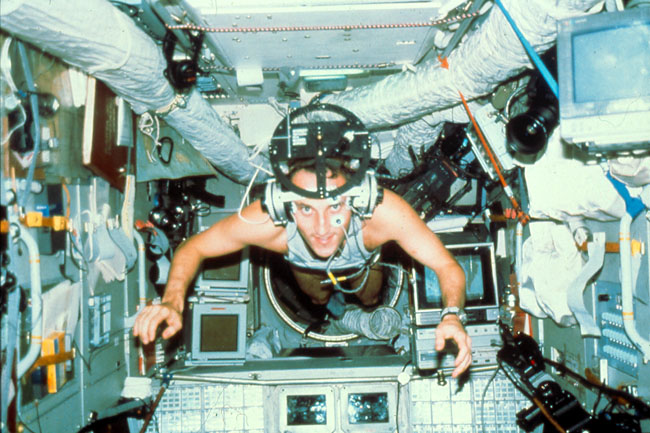
The second requirement was based on the technique realiability and the practical application of this technology in a spaceship. This point was confirmed with the successful technical implementation of the experiment. The AUDIMIR device functioned faultlessly and satisfied all requirements expected from it.
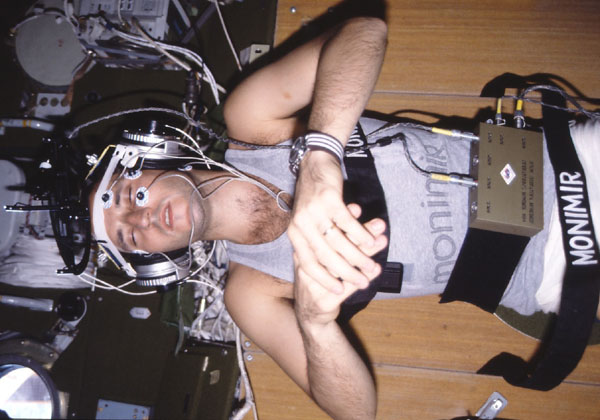
The second part of the experiment tried to create for the first time a subjective movement feeling in microgravity through audio-kinetic stimulation. In this case it was done with the simulation of a sound source circling the head. The test was attained: Franz Viehboeck had a rotating feeling during a waltz as well as by the perception of a white rotating hissing. The characteristic eye movements were also registered.
The strong rotating feeling generated by the audio-kinetic stimulation was used to measure the importance of acoustic orientation in microgravity. Therefore, for the first time, the influence of dynamic orientation could be proven with an audio-kinetic stimulus.
Practical application
Application ranges
- Binaural technic and technology
- Astronautics, aviation, work of operators
- Medical-biological basic research
- Clinical neurology
- Steric correct music playback over headphones
Application target
- Improvement of the quality and reliabilty of the communication technology
- Research acoustic cognitions and those interactions with other sensorial cognitions
- Differential diagnostic of steric figures in the brain
Direct interested institutions on the utilization of the experiment results
- AKG, Company AKG Acoustics GmbH, Vienna
- Scientific and clinical centers of neuro-physiological branch
Technical characteristics
The equipment AUDIMIR consisted of the following units
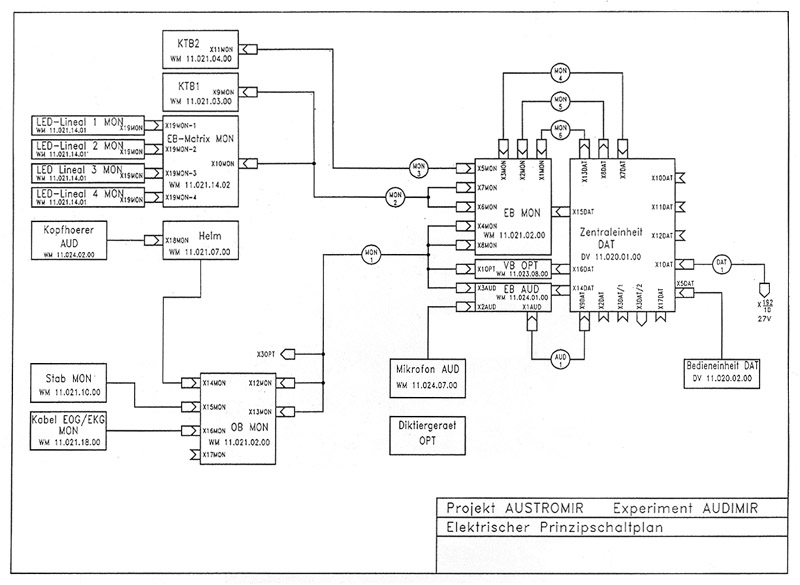
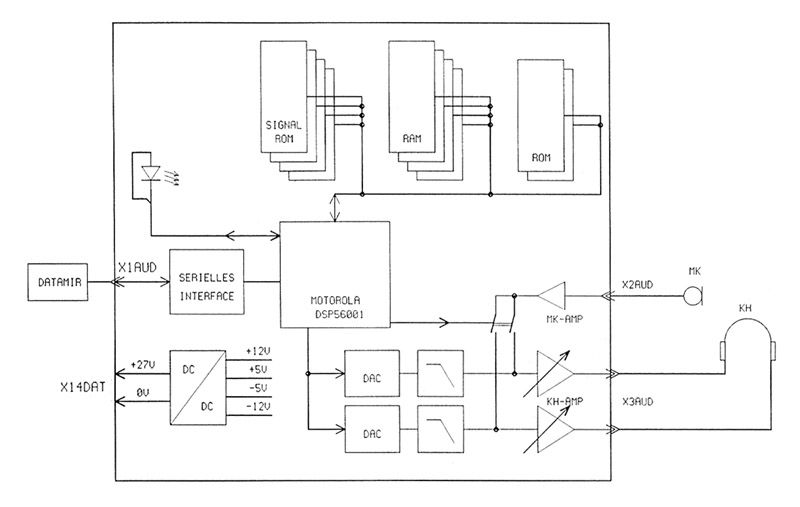
Electronic box (EB AUD) with cable AUD1
This unit was installed in the central unit of the system DATAMIR, the connecting cable to DATAMIR AUD1 was supplied completely mounted.
| Mass: | max. 1.3 kg |
| Dimensions: | 128 mm x 250 mm x 70 mm |
| Power input: | 5 W |
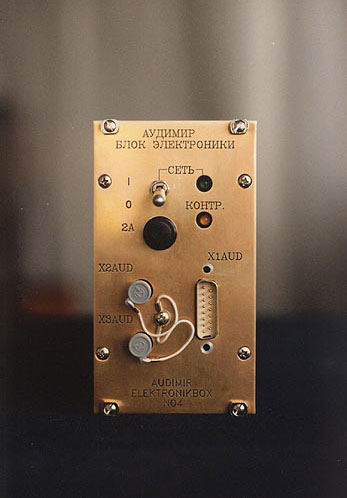
Aluminium container with equipment components
- Headphone shells AUD
- Microphone AUD
- Reserve fuses
| Mass: | max. 1.6 kg |
| Dimensions: | 205 mm x 190 mm x 93 mm |
Experimenters
Dipl.-Ing. Dr. Alexander Persterer (project manager)
Dr. Martin Opitz
Dipl.-Ing. Christian Koppensteiner
all: AKG, Company AKG Acoustics GmbH, Vienna
Univ.-Doz. Dr. Meinhard Berger (University Clinic for Neurology, Innsbruck)
Dr. Christian Mueller (Neurological University Clinic Vienna)
